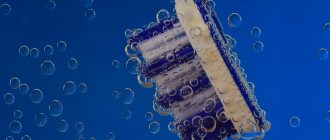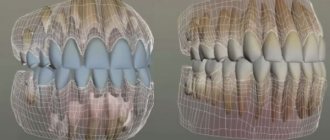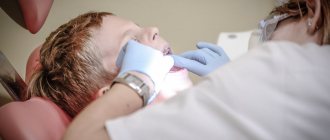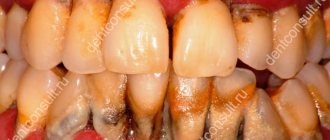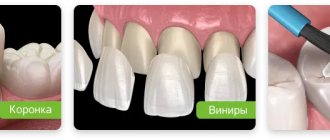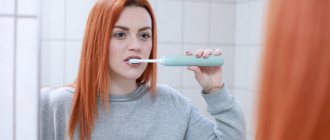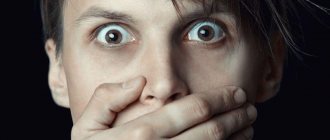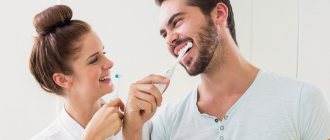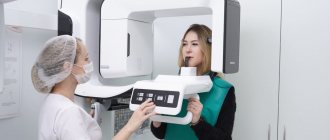Teeth before hygiene, chemical agent for staining plaque (used for educational purposes so that the patient can see areas that cannot be cleaned) and the state after hygiene.
There are a lot of questions about brushing your teeth, so let’s go over the main ones:
- What happens if you don't brush your teeth?
- Is it possible to brush your teeth rarely, but go to the dentist from time to time so that he can “powerfully clean” them for you?
- How is teeth cleaning performed in dentistry?
- Why do the Swiss brush their teeth without toothpaste at all?
- Does chewing gum work?
- Which brushes to choose and how? What about electric ones?
- Is it true that you should throw away the brush when at least one lint deviates from the vertical?
- Why do we need tongue scrapers, interdental brushes, dental floss and everything else?
- Does an irrigator replace brushing your teeth?
- Is mouthwash a good topic?
- When is it more important to brush your teeth - in the morning or in the evening?
- How does an IT professional differ from the average patient's oral health history?
Why brush your teeth at all? What happens if you don't touch them?
The oral cavity is the site of an ongoing battle between approximately 700 species of microflora.
Saliva is one of the most active fluids in the body. On the one hand, it must neutralize biological threats from the outside world, on the other, pre-process food, and on the third, protect teeth. From the point of view of evolutionary biodesign, the problem is solved very well if you eat what evolutionary biodesign offers from the outside world. For example, apples, large animals with tough meat, then unripe wild pears, carrots, and so on. Hard food cleans teeth perfectly without your help. Several tens of thousands of years ago, something went wrong, and man learned to cook food over fire. This gave rise to the first problems, but at that time they were not very significant, since in the light of the development of medicine and the lack of antibiotics, teeth were not the most important problem. But already in the twentieth century, when fast food, forced high-carbohydrate diets and soft, inconsistent food entered the masses, real difficulties began.
Plaque is a biofilm of bacteria that sticks to your teeth and does its best to protect itself from aggressive saliva and other cleaning methods. In this regard, bacteria are greatly helped by adhesive microfragments of food, which remain in the form of such glue on the teeth. For example, crumbly cookies or pizza dough combined with dead cells create a good bioglue. Bacteria land on it and begin to colonize your tooth. Their goal is to get inside and set up a base there. We call this caries. Most often, developed caries is just amphora-shaped: a small entrance hole and a sea of destruction inside the tooth.
This is how the patient comes:
Here is hidden caries revealed:
And here is the end of the therapist’s work:
Hidden caries can, in principle, be detected by radiography and transillumination.
If you remove this biofilm in time, there will be no caries. But it is quite strong, so either a strong antiseptic is needed (the same alcohol, which also harms other parts of the system, starting with the oral cavity), or mechanical treatment (with an apple or a toothbrush). A large amount of saliva partially washes away the films, but not all of them: for example, they remain at contact points and under the edge of the gums.
Several layers of biofilm form a calculus - tartar. This is a pretty disgusting reinforcement of bacteria. It is disgusting with its unique smell and taste (which your partner often feels with every kiss). But from a medical point of view, this is not the main thing. The main thing is that tartar still puts pressure on the gums and impedes the blood supply to the gums, creating complex inflammations. Well, no one ruled out caries. Imagine that several grains of sand have stuck into your hand, and they stick out there for months, gradually increasing in size. Tartars are about as unpleasant, but due to the nature of their innervation, you almost don’t feel them.
So, if you don’t brush your teeth, a biofilm will form very quickly. And if you don’t touch the biofilm, a calculus forms, which triggers many unpleasant processes. It is an accepted medical practice to brush your teeth after breakfast and dinner.
How to brush your teeth with an electric toothbrush?
The pattern of brushing teeth with an electric toothbrush differs from brushing with a regular manual toothbrush. Electric brushes have a built-in motor, and sonic and ultrasonic models also have a high-frequency generator. They cause high-frequency pulsation of the bristles and movement of the cleaning head, due to which cleaning occurs.
The user does not need to apply pressure to the toothbrush, sweeping or circular motions, because the electric model handles these tasks on its own. To brush your teeth, you need to moisten the bristles, apply a little toothpaste to it, place the brush in your mouth, turn it on and simply move it without pressure or unnecessary movements from one tooth to another.
Please note that the cleaning technique may differ depending on the type of electric brush (rotary, sonic, ultrasonic). Therefore, the exact method of correct use should be read in the instructions for the specific model before first use.
When is it more important to brush your teeth - in the morning or in the evening?
It may seem that brushing your teeth in the morning and at night is equally important.
But no, evening cleansing is much more important. At night, your body produces less saliva (this is one of the reasons why your mouth is dry in the morning). Less saliva on your teeth means less protection for them. Less protection means faster biofilm formation. That is, if you brush your teeth in the morning so that your breath does not smell when talking, then in the evening you need to brush your teeth for medical reasons. Most teeth brushing techniques suggest that evening brushing should be longer than morning brushing.
In the dictionary Complete accentuated paradigm according to A. A. Zaliznya
clean, clean, clean, clean, clean, clean, clean, clean, cleaning, cleaned, cleaned, cleaned, cleaned, clean, clean, clean, clean, cleaning, cleaning, chi cleaning, cleaning, cleaning, cleaning, cleaning, cleaning, cleaning, cleaning, cleaning, cleaning, cleaning, cleaning, cleaning, cleaning, cleaning, cleaning, cleaning, cleaning, cleaning, cleaning, cleaning, cleaning, cleaning, chi cleaning, cleaning, cleaning, cleaning, cleaning, cleaning, cleaning, cleaning, cleaning, cleaned, cleaned, cleaned, cleaned, cleaned, cleaned, cleaned, cleaned, cleaned, cleaned, cleaned, cleaned, cleaned, cleaned, cleaned, cleaned, cleaned, cleaned lice, cleaned, cleaned, cleaned, cleaned, cleaned, cleaned, cleaned, cleaning, being cleaned, being cleaned, being cleaned, being cleaned, being cleaned, being cleaned, being cleaned, being cleaned, being cleaned, being cleaned, being cleaned, being cleaned, being cleaned, being cleaned, being cleaned, being cleaned, being cleaned, being cleaned, being cleaned, being cleaned, being cleaned, being cleaned, being cleaned, being cleaned, being cleaned, being cleaned, being cleaned, being cleaned, being cleaned, being cleaned, being cleaned, being cleaned, being cleaned, being cleaned, being cleaned, being cleaned, being cleaned, being cleaned, being cleaned, cleanable, being cleaned, being cleaned, being cleaned, being cleaned, being cleaned, being cleaned, being cleaned, being cleaned, being cleaned, being cleaned, being cleaned, being cleaned, being cleaned, being cleaned, being cleaned, being cleaned, being cleaned, being cleaned, being cleaned, being cleaned, being cleaned, being cleaned, being cleaned, being cleaned , being cleaned, being cleaned, being cleaned, being cleaned, being cleaned, cleaned, cleaned, cleaned, cleaned, cleaned, peeled, peeled, peeled, peeled, peeled, peeled, peeled, peeled, peeled, peeled, peeled, peeled, peeled, peeled, peeled, peeled, peeled, peeled, peeled no, cleaned, cleaned, cleaned, cleaned, cleaned, cleaned, cleaned, cleaned, cleaned, cleaned, cleaned, cleaned, cleaned, cleaned
Share the meaning of the word:
Is it possible to independently assess areas of biological damage?
Yes, you can. To do this, you need to buy either Curaprox, Dynal tablets, or Curaprox, PresiDENT liquid at your nearest pharmacy. The tablets are chewed to a cheerful foam and spat out. Considering that you need to carefully and thoughtfully read the instructions to the end, it is better to buy a liquid; it is applied with a special swab or cotton swab. It will be more reliable. But if you have not had hygiene for the last two to three months, then it is better to do it on Friday evening. In fact, it washes off almost immediately, but there is a chance that particularly severe lesions will be stained for about 50 hours. This happens quite rarely and with poor hygiene, but it is a matter of chance.
In the Dictionary of Synonyms
clean, clear, clear, sweep, brighten, scrape, wash, wash, rinse; filter, strain, settle, reduce (remove) stains; cleanse the Augean stables; to polish, to polish, to polish, to peel, to scold, to peel, to knock out, to scrape, to clear, to scrape out, to scratch, to scold abusively, to scold in the last words, to bastard, to clean off, to scold, to re-clean, to clean up, to wash, to brighten, to polish, to peel, to scold on what is worth, beat, tear, bone, peel, wax, shower with abuse, shower with curses, scrape, wipe, send away, call names, remove, remove, hit, scold, rob, lick, clean, scratch, lick, poke, cover , peel, rob, honor, peel, bake, cover, cleanse. Ant. pollute, pollute
What happens during dental hygiene?
First, the hygienist looks at the size of the stones.
If there are very large ones, then we break them up with ultrasound. Next, we work with the plaque manually using rotating brushes, rubber bands and paste. If you need to get under the gum, there are curette hooks that can be used to clean difficult areas and smooth the surface of the roots so that rotting food does not linger there. Then each gap between the teeth is treated with floss and fine sandpaper. The teeth are then polished. The next stage is strengthening: a disposable mouthguard with a remineralizing solution is placed on the teeth. It then discusses how best to brush your teeth in the future. Then there are two approaches: “industrial” and “archaeological”. If you see sandblasting on soda, then in front of you is a hygienist who wants to do it quickly and powerfully. However, due to the design features of this equipment, it is very difficult to ensure a balance of efficiency and safety, so we consider this approach not the best from the point of view of its relationship to the tissues of the oral cavity (the rough surface of the tooth after a large abrasive gives greater adhesion to sticky food, gum damage is not uncommon). Manufacturing companies are trying to solve this problem, but for now our choice is mechanical contact cleaning.
During cleaning, various chemical agents and “soft” abrasives can be used. If there is inflammation of the gums (which is often associated with “blockages” of stones), then treatment with special antiseptics and agents may be necessary to relieve inflammation. In this case, the appointment is often divided into two: first, the stones above the gum line are removed, then five to seven days pass until the inflammation caused by them subsides, and then the stones below can be worked relatively safely. If you do everything in one go, it won’t be very beautiful: there will be blood in all directions. It’s not that we feel sorry for doing this, it’s just that it prevents us from properly assessing the results of the work inside this bloody mess. That's why we love it when it's clean, the patient doesn't break out and doesn't panic. Gingivitis starting from the middle stage = two doses a week apart.
The procedure itself is painless, but sometimes patients feel ticklish. Sometimes grinding an instrument against your teeth causes unpleasant emotions. There is no problem doing everything under local anesthesia: this is exactly the case when you don’t need to be afraid to ask for it.
Hygiene is done before any more or less serious intervention, since it allows for correct diagnosis later and correctly taking into account the shape of the teeth. Well, the fewer dangerous bacteria there are during invasive procedures near the field, the better.
How to brush your teeth correctly?
A colleague of mine recently wrote about the characteristic “programmer teeth”.
About half of the problems in these cases are associated with insufficient salivation of the oral cavity: this is a completely predictable consequence of night work, stressful focus on the task and various problems with eating. Since I have very little faith that after reading this someone will suddenly start eating right or change their daily routine, let’s tell you how to properly brush your teeth using the Swiss method. It is most suitable for those who have a busy schedule, stress and poor nutrition. That is, for all adults in large cities. It's called the BASS technique (more precisely, the advanced Bass teeth brushing technique). It is one of about two dozen techniques available. Note that we still don't know which teeth cleaning technique is best out of all the different ones out there. If you are interested, this issue was raised in Nature: here is an analysis of recommendations from various sources, textbooks and a selection of studies. The result is that the Bass technique is too complicated for children, but for adults it gives the best results. Moreover, all studies that numerically confirm this were carried out over a fairly short observation period.
Sorry for the compression, this is the original image quality from a study of 180 healthy children.
Blue was and became - this is your usual horizontal brushing, red - circular with closed teeth, green - according to Bass. Here is another study with a longer follow-up period. This is partly due to the fact that it is difficult to follow patients and stand over them every time they brush their teeth. Nevertheless, this method is currently one of the best, judging by scientific data and practice. Here's what to do:
1. Buy a soft toothbrush with the most bristles. The shape is strictly straight (both the handle and the fleecy part without bends or protrusions). You still won’t be able to do anything better with a hard or medium-hard brush, but a soft one cleans much better and without damage: we will work on the border with the gum.
I recommend Curaprox ultrasoft 5460, Revyline, TePe brushes, but you can choose any similar ones.
2. Take the brush like a handle (not in a fist) and place it at a 45-degree angle to the gum vertically, so that the bristles go under the edge of the gum. You will feel it. Half of the brush should be on the crown of the tooth, half on the gum. Next, start moving the brush so that you get such long ovals. Gradually work your way across all teeth from the front, working at the edge of the gum.
Do not move the brush with your elbow or forearm, only with your hand. You should get very soft smooth movements.
3. Brush the inside of your teeth in the same way, but hold the brush vertically.
4. After this, make the usual horizontal movements along the edges of the teeth and their frontal surfaces.
The procedure is slower than usual haphazard cleaning, since you need to go over all the teeth very carefully at the edge with the gum. In the morning it takes three minutes, in the evening - more than five minutes. In Switzerland, people brush their teeth for seven to ten minutes, leaving the bathroom with a brush without toothpaste. This is a very good practice, and I recommend it: just take a brush and sit down to watch YouTube or do something else and work gently along the edge of the gum. The point of the method is not only that you can do something else while brushing your teeth (fortunately there is no toothpaste), but also that you do not see your reflection. When you control a brush based on visual cues, it always dramatically reduces the quality of brushing compared to brushing without a mirror, because different sensory systems are involved. And sensations are more important than vision here.
How to clean crowns, implants and braces?
We all know how to brush our teeth. From a very young age, we are taught that to prevent caries we need to brush our teeth 2 times a day - in the morning after meals and in the evening before bed .
How to brush your teeth correctly
However, after dental treatment with the installation of braces, dentures or implants, teeth cleaning becomes more complicated and can turn into a real quest. This means you will need tips and special recommendations.
How to get around these numerous locks and how to clean the plaque around the braces? How to care for implants? Are special brushes needed for artificial crowns?
In this article, dentists from the KANO clinic network will clarify the issues of caring for teeth with dental structures.
How to clean crowns, implants and braces?
Veneers, crowns, bridges
After fixing ceramic veneers or crowns, you will not have any problems with cleaning them. After all, structures of this type completely repeat the anatomical shape of the teeth and are installed under the gum. Thanks to this, plaque does not settle at the border of the restoration and the tooth. In addition, ceramic structures are made in such a way that their surface is as smooth as possible, like its own enamel.
But if a bridge , then you will need additional hygiene accessories. It's all about the design of the prosthesis: in the area of the missing tooth, a so-called intermediate part is created - an imitation of the tooth. Such a hanging tooth never lies on the gum and does not put pressure on it in order to avoid “bedsores.” In the area of the front teeth, the intermediate part of the prosthesis slightly touches the gum, and in the area of the lateral teeth it lags somewhat behind the gum - it has a flushing part. This is designed specifically for ease of cleansing.
Hygiene after prosthetics
Superfloss, a dental brush and an irrigator will help you remove food debris from under the bridge and clean out plaque .
Read more about floss and brush
Irrigator
The unusual name “irrigator” hides an extremely useful device for home teeth cleaning. This is a compact device that delivers a stream of water under pressure to your teeth. Or not water, but a special solution - you need to pour it into the irrigator container yourself. You direct the nozzle to the gum area, the spaces between the teeth and under the rinsing part of the bridge - and the food remaining there is quickly washed away with a stream of liquid.
The intensity of the pressure can be adjusted, gradually increasing as you get used to the irrigator. In addition to removing plaque and food debris, the gums are effectively massaged, which improves microcirculation and prevents the development of gum disease.
Dentists from the KANO clinic network recommend purchasing an irrigator after installing any permanent structure.
Oral irrigator
The irrigator can be:
- Stationary: it can be placed on a shelf in the bathroom and, connected to a power source, can be used by the whole family. The main thing is for everyone to choose their own removable brush head, because they, like toothbrushes, should be individual.
- Portable: Similar in size to an electric toothbrush, it runs on a battery, making it easy to take with you on trips.
Irrigators tested and approved by our dentists: AquaPick, Oral-B, Philips AirFloss.
In a similar way, you can put in order the therapeutic version of the bridge - the adhesive prosthesis. Using superfloss (for example, from Oral-B ) and an irrigator, you can fully care for such a restoration.
Our dentist-therapist Ekaterina Konstantinovna Podobed will tell you how to clean composite veneers
And if you have a removable denture as a temporary splinting or restorative structure, then it is important to remember that it needs to be washed after every meal and cleaned every day - with a separate hard brush.
Implants
Well, implantation is over! Everything turned out to be not as scary as the imagination had pictured, moreover, in fact, it wasn’t even scary at all. But sometimes, in stressful situations, all the doctor’s words can fly out of your head, and then the patient leaves the office as if in a fog - without any idea of what to do next with the implants. Therefore, we have collected the main recommendations for you in one brochure article:
Recommendations after dental implantation
When, after installing an implant, the gum above it is tightly sutured, then it turns out that there is nothing to clean there. And if something is visible from under the gums - a gum former or a temporary crown is installed - then they also need to be looked after. You can clean with regular toothbrushes, but it is more effective to do this with specialized brushes. Curaprox and TePe have these , they can be recognized by the mark “for implants”. Other monotuft brushes are also good for this purpose.
Hygiene after implantation
Proper hygiene level must be maintained by using the irrigator . With its help, you can wash the space between the implant and the gum, and a brush, superfloss and dental brushes .
You should start using the irrigator one month after the implants are installed.
The same simple recommendations should be followed after fixing permanent crowns: metal-ceramic, zirconium or Cerec crowns. Even if it seems to you that the crown on the implant is installed very tightly, you can and should still carefully clean underneath it.
All-on-4/6 implantation
The rules for caring for implants after complex implantation of All-on-4/6 do not differ from the classical rules for caring for implants: superfloss, monotuft brushes and an irrigator . It will be very good if you can purchase a portable irrigator and use it after every meal.
The rules of hygienic care after complex implantation of All-on-4/6 will be explained by our orthopedic dentist Anton Pavlovich Dobritsky:
However, home teeth cleaning alone is not enough to fully care for your implants. In order for implants to serve for decades, it is necessary to undergo professional implant hygiene . After all, the basis for the stability of an implant is the absence of plaque microorganisms around it.
How to extend the warranty on implants? You will find out the answer by watching our video:
Braces
On the first day after fixing the braces system, patients may feel slightly confused. How can you even clean food from under all these arches, rubber bands and clasps?
Yes, if you're not used to it, the time spent brushing your teeth will increase. Now for any brace wearer there are 2 types of teeth cleaning:
- cleaning after each meal (brush + brush and floss if necessary). Orthodontic patients should always carry a toothbrush and brush . After all, pieces of food get clogged under the arch, get stuck under wire and elastic ligatures, and get wrapped around braces (especially greens, melted cheese, halva). Agree, it looks unsightly.
- comprehensive teeth cleaning in the morning and evening (toothbrush + superfloss + brush + irrigator). Twice a day it is necessary to use not only a toothbrush (labeled Ortho or single-tuft), but also a superfloss to clean between the teeth. Around each bracket, it is necessary to additionally remove plaque using an interdental brush (TePe, Revyline) - it must be selected in size for ease of use. Don’t forget about the irrigator, because when cleaning teeth around braces, not a single product will be superfluous!
Brushing teeth with braces
An excellent additional means of supporting enamel is Tooth Mousse cream-gel. It saturates dental tissue with calcium and phosphorus ions, restoring mineral balance and preventing tooth decay.
During treatment with braces, dentists recommend that you undergo comprehensive teeth cleaning with Air Flow more often than usual - once every 3 months .
After all, if you neglect hygiene, then after removing braces you will see straight teeth in the mirror - but with white or even brown spots of caries.
Hygiene after dental intervention
Indeed, brushing teeth with dental structures requires a certain skill from the patient. However, if you approach the matter with enthusiasm and choose convenient equipment, the process of home hygiene will become a pleasant regular ritual for you. And the dentists at KANO clinics will be happy to explain all the nuances of cleaning crowns, braces and dentures and recommend the care products that are suitable for you.
Is it true that you should throw away the brush when at least one lint deviates from the vertical?
Yes, if the bristles on your brush are no longer vertical, it is better to change it.
Typically, brushes are changed about once a month, but high-quality options from the recommendations above can be changed once every three months with the right manual skills. It is also very important to change your brush after hygiene at the dentist: they “restart” the microbiota of your oral cavity, and it is not very good to introduce old pathogenic ones from an old brush.
Pharmacies sell disposable toothbrushes with dry granules and beneficial enzymes. I recommend keeping one in your bag; it's a great option if you find yourself wanting to look and smell perfect.
Why do we need tongue scrapers, interdental brushes, dental floss and everything else?
A tongue scraper is very important because the tongue needs to be cleaned too. You can do this with a separate brush, but a scraper is much more convenient and effective. I recommend double scrapers, here are a couple of examples: Curaprox double and TePe. It is better to use the scraper before the main cleaning, passing over the tongue literally three to four times.
Dental floss is not recommended at this time. More precisely, it is very good for cleaning fiber from meat after a restaurant (and better than not having it at all), but it is bad if you do not know how to use it correctly. But almost no one knows how: you can’t touch your gums with it. Therefore, a more modern approach is interdental brushes. They look like this:
As you can see, they are different colors for different intervals. They need to be selected with a doctor using a special probe, which is inserted between specific pairs of teeth. It’s better not to do this on your own. To summarize: it is better to forget about brushes, as well as about thread, until your doctor directly advises you to do so.
Mouthwash is good during the day after meals, as long as it does not contain alcohol. It works better with alcohol, but damages teeth and soft tissues (primarily mucous membranes). Without alcohol it is worse and is not suitable as a replacement for a full-fledged cleaning, that is, it is better to use it only during the day if you need to get rid of odor or clean your mouth after eating.
There are also foams like Water Dent - they restore the environment to a slightly alkaline environment, which is much better than the acidic environment after a meal (and especially after coffee). Some mouthwashes work the same way.
Dental floss - anytime
There is no consensus on when exactly to floss: before or after brushing. Dr. Ritchie himself does this during cleansing. But he emphasizes that this is not a prerequisite.
"As long as you brush your teeth twice a day with fluoride toothpaste and use floss or other interdental cleaning products, you shouldn't have to worry," says Alice Boghosian, a spokeswoman for the American Dental Association. - Do as you feel comfortable. The main thing is to clean the spaces between your teeth every day.”
Does the irrigator work?
A toothbrush removes about 70% of biofoci. The rest are located where mechanically cannot be reached, for example, at contact points. So yes, the irrigator complements regular teeth cleaning very well. If you can, use it every time. But just don’t take stationary ones that require connection to a household power supply. Practice shows that my patients do not use these because of the difficulty of turning them on in the bathroom. It’s better to use mobile phones with batteries, they are much simpler and always at hand near the sink.
How to charge the brush
A new brush must be charged to its full capacity - the full charging time is indicated by the manufacturer in the instructions and can take up to 48 hours. Charging time depends on the battery capacity and other technical characteristics of the brush.
Many brushes have a charging indicator, which will help you understand the current state of the battery. If your brush has a nickel-metal hydride battery, you should charge it only after it is completely discharged. Brushes with lithium-ion batteries can be charged at any charge level.
When charging, the brush must be in a vertical position. It is best to charge the brush directly from the mains, without using intermediate devices such as a power bank or tablet - this is not only faster, but also safer.
Which pasta to choose?
Any with low abrasiveness is suitable.
Pastes with calcium work, but only if the paste is left on the teeth for a long time. I do not recommend whitening toothpastes, toothpastes for smokers or coffee lovers. Look at the abrasiveness index, the best options are around RDA 50–70 units. In the morning you can use antibacterial, but in the evening - only regular. I recommend pastes such as Biorepair Night, Apadent, ROCS “Active Calcium”, Curaprox. I don’t particularly recommend the Russian versions of Colgate and Blendamed: they have changes relative to the foreign composition, which makes the environment more aggressive. Milk and cottage cheese do not affect teeth (calcium from them almost does not enter the enamel). Pastes have little effect, but with 10-minute cleanings the results are noticeable. Usually, when a patient has problems with calcium, special gels are prescribed in courses of two weeks every three months.
A couple of links to research.
Is it true that dentists don’t want to teach us how to brush our teeth?
It may seem that the dentist has a vested interest in you brushing your teeth incorrectly.
Because if you teach it correctly, you won’t come back with caries or without a tooth at all. There are two exceptions:
- Hygienists who want to help the patient. This is either an ordinary human desire to do well, or the basis of the clinic’s work: good service is noticeable, and such a clinic is trusted much more (that is, they return much more often, and if a patient has been with the clinic for 10 years, then sooner or later he will statistically need expensive services) .
- And manufacturers of paste brushes and irrigators understand that the right set of consumables and instruments in the patient’s hands brings them quite a lot, so they try to train people in the correct processes, including through clinic hygienists.
We created the clinic as a way to make money at the cutting edge of applied science, but very quickly clients began telling their friends about us as one of the most caring dentistry in Moscow.
We were counting on “the most technically advanced”, but that was also nothing. I hope that “the most caring” contains my contribution, because I explain in great detail and detail how to avoid getting into the chair next time. And with me, you can practice brushing your teeth separately from the appointment: a hygiene lesson lasts 40–60 minutes, and the price includes the necessary set of brushes and brushes. PS If you come to our clinics, then say that you are from Habr, there will be a 5% discount.
In Efremova's dictionary
Emphasis: cleanse the nes. trans.
- Remove dust, dirt, etc. from something, to make clean; cleanse
- Apply gloss by polishing until shiny.
- To free from unnecessary, superfluous, preparing for smth.
- trans. decomposition To subject to examination in order to liberate or free oneself from harmful, unnecessary, alien elements, to separate the healthy from the unfit.
- To remove, cut off the peel, skin, scales from something. (fruits, vegetables, fish, etc.).
- Release fruits, grains, etc. from seeds, stems, litter.


